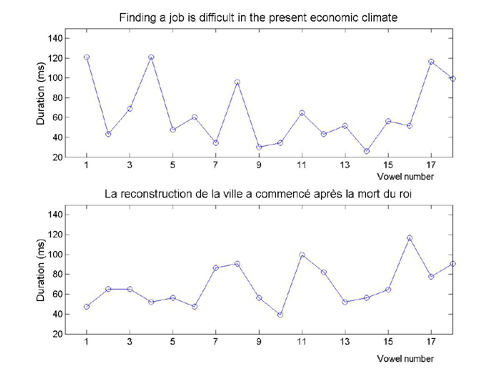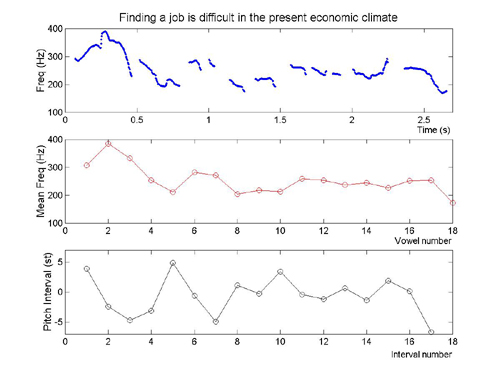Aniruddh D. Patel - apatel@nsi.edu
John R. Iversen
Jason C. Rosenberg
The Neurosciences Institute
10640 John Jay Hopkins Drive
San Diego, CA 92121
http://www.nsi.edu/users/patel
Popular version of paper 5aSC13
Presented Friday morning, November 19, 2004
148th ASA Meeting, San Diego, CA
What makes the music of Sir Edward Elgar sound so distinctively English? (Think
of Pomp and Circumstance, the march which accompanies many graduation
ceremonies.) Similarly, what makes the music of Debussy sound so French? Some
musicologists and linguists have argued that "national character"
in music stems from a relationship between music and speech. Specifically, they
have suggested that instrumental classical music can reflect the melody and
rhythm of a composer's native language (speech "prosody"). Evidence
for this idea, however, has been largely anecdotal. We have addressed this issue
with new methods which allow us to directly compare rhythm and melody in speech
and music. Focusing on British English and French, we find that instrumental
music in these two cultures does indeed reflect the prosody of the national
language. Thus the language we speak may influence the music our culture produces.
Languages differ not only in the words and speech sounds they employ, but also
in their rhythm (temporal and accentual patterning) and in the way voice pitch
rises and falls across phrases and sentences ("intonation," which
refers to speech melody rather than speech rhythm). Linguists have long claimed
that English and French have distinct rhythmic and intonational properties,
but it has been difficult to find quantitative measures which distinguish between
the prosody of the two languages Fortunately, new methods for studying language
rhythm have recently been proposed, and one such method has proven quite fruitful
for comparing language and music. It is best illustrated by way of an example.
Consider Figure 1, which shows the pattern of vowel duration in a sentence of
British English and a sentence of continental French. These sentences can be
heard in Sound Examples 1 and 2.

The sentences in Figure 1 are ordinary news-like utterances read by native
speakers of each language. Each panel of the figure shows the duration of successive
vowels in the corresponding sentence (in milliseconds). Thus in the top panel,
the first data point represents the duration of the first vowel in the word
"Finding," which is about 120 milliseconds (ms) long, the second point
is the duration of the second vowel in "finding," which is about 40
ms long, and so on. The key thing to notice is that adjacent vowels in the English
sentence tend to differ more in duration than do adjacent vowels in the French
sentence. That is, in the English sentence it is quite common for a relatively
long vowel to be followed by a relatively short one (or vice versa), while in
the French sentence the duration of neighboring vowels tends to be more similar.
Speech researchers recently developed a way to quantify the average degree of
durational contrast between neighboring vowels in a sentence, called the "normalized
Pairwise Variability Index" or nPVI2,3. It turns out that this value is
significantly higher, on average, in British than in French sentences4. This
likely reflects the greater durational disparities in English than in French
between vowels in stressed and unstressed syllables5.
Since the nPVI can be applied to any sequence of durations, it can also be applied
to a sequence of musical notes, such as a theme from a symphony by Elgar or
from a piece by Debussy. In a previous study, we applied the nPVI to the instrumental
music of 16 British and French composers6, analyzing several hundred themes
from a well-known musicological sourcebook7. We focused on composers who lived
and worked around the turn of the 20th century, as this is considered a period
of musical nationalism. We found that the nPVI of English music was significantly
higher, on average, than that of French music. In less formal terms, English
music rhythmically "swings" more than French music, just as English
speech rhythmically swings more than French speech.
Having found a parallel between rhythm in speech and music, we recently turned
our attention to melodic issues. Using the same databases of speech and music,
we asked if there was a difference between English and French intonation which
was reflected in the music of the two nations. When studying rhythm, we had
the benefit of an existing quantitative measure (the nPVI) which differentiated
between English and French speech and which could be applied to music in a straightforward
way. In the case of intonation, no such measure was available. Thus we devised
a novel way of quantifying melodic patterns in speech, using a method which
could be adapted to music.
Although the physical manifestation of melody in speech - the fundamental frequency
of the voice - moves by continuous glides rather than by discrete frequency
steps, some speech scientists have suggested that speech melody is perceived
as a sequence of distinct syllable pitches8. We used a simplified
method to compute each syllable's perceived pitch, based on the mean fundamental
frequency of each vowel, since vowels form the core of syllables. Thus for each
sentence in our database, we converted the continuous fundamental frequency
contour of the sentence into a sequence of discrete frequencies which we call
"vowel pitches." (Note that these pitches do not conform to any musical
scale.) The top panel of Figure 2 shows the original fundamental frequency contour
of the English sentence of Figure 1 and Sound Example
1. The middle panels shows the sequence of vowel pitches for this sentence:
i.e. the pitch of the voice goes up from the first to the second vowel of "Finding,"
and then goes down for the next three vowels in "a job is," and so
on.
Just as one can compute pitch intervals between notes in a musical melody,
one can also compute pitch intervals between successive vowel pitches in a sentence.
The bottom panel of Figure 2 shows the intervals between the successive vowel
pitches of the example sentence, in units of semitones. (A semitone is the pitch
distance between an adjacent black and white key on a piano.) Note how the interval
between the first and the second vowel of "Finding" is an upward leap
of about 4 semitones, while the interval between the second vowel of "Finding"
and the following vowel ("a") is a downward step of about 2.5 semitones,
and so on. Unlike on a piano, vowel pitch intervals are not constrained to whole-numbers
of semitones: these intervals can fall between the cracks of standard Western
musical intervals. References 1. Nazzi, T., Bertoncini, J., & Mehler, J. (1998). Language
discrimination in newborns: Toward an understanding of the role of rhythm.
Journal of Experimental Psychology: Human Perception and Performance, 24 (3),
756-777. 2. Low E.L., Grabe, E., & Nolan, F. (2000). Quantitative
characterizations of speech rhythm: Syllable-timing in Singapore English.
Language & Speech, 43 (4), 377-401. 3. Grabe, E. and Low, E.L. (2002) Durational variability in
speech and the rhythm class hypothesis. In C. Gussenhoven & N. Warner
(Eds.), Laboratory Phonology 7 (pp. 515-546). Berlin: Mouton de Gruyter. 4. Ramus, F. (2002). Acoustic correlates of linguistic rhythm:
Perspectives. In: Proceedings of Speech Prosody, Aix-en-Provence, 115-120. 5. Dauer, R.M. (1983). Stress-timing and syllable-timing reanalyzed.
Journal of Phonetics, 11, 51-62. 6. Patel, A.D. & Daniele, J. (2003). An empirical comparison
of rhythm in language and music. Cognition, 87, B35-B45. 7. Barlow, H. & Morgenstern, S. (1983). A Dictionary of
Musical Themes, Revised Edition. London: Faber & Faber. 8. d'Alessandro, C. & Mertens, P. (1995). Automatic pitch
contour stylization using a model of tonal perception. Computer Speech and
Language, 9 (3), 257-288.

Figure 2. The speech melody of an English sentence. The top panel
shows the original fundamental frequency contour of the voice, the middle panel
shows successive vowel pitch values, and the bottom panel shows vowel pitch
intervals (in semitones). The sentence can be heard in Sound
Example 1.
We quantified the pattern of vowel pitch intervals for each sentence in our
database, and found that the average vowel-to-vowel pitch movement was about
the same size in English and French sentences (about 2 semitones). However,
the intervals in French sentences were significantly less variable in size than
in English sentences. Put another way, as the voice moves from one vowel to
the next in a sentence, the size of each pitch change is more uniform in French
than in English speech.
To see if this difference between the two languages was reflected in music,
we turned to our database of turn-of-the-century composers, and examined the
same set of musical themes which we had previously analyzed for rhythm. For
each theme we measured the pitch intervals between successive notes (in semitones),
and then computed the variability of these intervals, just as we had done for
speech. Our findings paralleled what we found in speech: interval sizes in French
themes were significantly less variable than in English themes. As the melody
moves from one note to the next in musical themes, the size of each pitch change
is more uniform in French than in English music.
Our results are shown in Figure 3, which combines our findings on rhythm and
melody in speech and music. The x-axis shows rhythm (the degree of durational
contrast between vowels in sentences or notes in musical themes), while the
y-axis shows melody (pitch interval variability between vowels or notes). By
plotting rhythm and melody together, a striking pattern emerges, suggesting
that a nation's language exerts a "gravitational pull" on the structure
of its music.
Supported by Neurosciences Research Foundation as part of its
program on music and the brain at The Neurosciences Institute, where ADP is
the Esther J. Burnham Fellow and JRI is the Karp Foundation Fellow. We thank
J. Burton, B. Repp, J. Saffran & B. Stein for comments.

Figure 3. Rhythm and melody in British English and French speech
and music. The x-axis shows the degree of durational contrast between successive
vowels/notes in sentences/musical themes (measured using the nPVI), while the
y-axis shows the variability in the size of pitch movements between successive
vowels/notes in sentences/themes (measured using the coefficient of variation
of absolute interval size). English data are shown in red and French data in
blue. Circles represent mean values for speech or music, and lines are standard
errors. English composers studied were: Bax, Delius, Elgar, Holst, Ireland,
and Vaughan Williams. French composers studied were: Debussy, D'Indy, Fauré,
Honegger, Ibert, Milhaud, Poulenc, Ravel, Roussel, and Saint-Saëns.